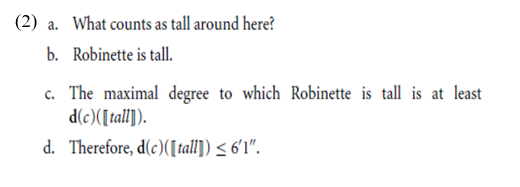


 Grammar
Grammar
 Tenses
Tenses
 Present
Present
 Past
Past
 Future
Future
 Parts Of Speech
Parts Of Speech
 Nouns
Nouns
 Verbs
Verbs
 Adverbs
Adverbs
 Adjectives
Adjectives
 Pronouns
Pronouns
 Pre Position
Pre Position
 Preposition by function
Preposition by function 
 Preposition by construction
Preposition by construction
 Conjunctions
Conjunctions
 Interjections
Interjections
 Grammar Rules
Grammar Rules
 Linguistics
Linguistics
 Semantics
Semantics
 Pragmatics
Pragmatics
 Reading Comprehension
Reading Comprehension
 Teaching Methods
Teaching Methods|
أقرأ أيضاً
التاريخ: 2023-04-06
التاريخ: 2024-08-25
التاريخ: 2024-08-25
التاريخ: 2023-03-16
|
A case study of the semantics of clear - Vagueness
Following Barker (2002) and Barker and Taranto (2003), the solution to the paradox of asserting clarity involves adopting a delineation function that takes a situation and an adjective meaning and returns the vague standard for the adjective in the given situation. An introductory example is best used with a vague predicate that is easier to quantify than clarity. One such predicate is tall, which operates over a scale of height. Specifically, this predicate is concerned with maximal length on the vertical axis. A delineation function written to capture the meaning of tall as used in an utterance of (1a) is written as (1b), and its truth condition is expressed in (1c).

The truth condition in (1c) guarantees that the applicability of tall is evaluated with respect to Robinette’s maximal height.
As explained in Barker (2002), sentences like (1a) have both descriptive and metalinguistic uses. In its descriptive use, tall provides information about the maximal length of an object with respect to the vertical axis and the conventionally accepted minimum standard for tallness. If in a situation the definition in (1b) returns a value of 6́ 0˝, an utterance of (1a) provides the information about the lower bound on how tall Robinette is, in this case, 6́ 0˝.
As an illustration of its metalinguistic use, imagine a situation in which a speaker and addressee know a lot about Robinette, including the maximal degree of his height, which is 6́ 1˝. In contrast to our scenario to illustrate the descriptive use of tall, in this situation the standard for human tallness is more obscure. The discourse participants have their individual ideas about how tall a person needs to be to count as tall, but there is uncertainty about the conventional standard for height. In this case, a discourse like the one in (2) may occur.

Here, the addressee of (2b) has learned nothing new about Robinette by the information associated with the truth condition as expressed in (2c). However, the addressee has learned something about the prevailing standard for tallness. Specifically, it must be less than or equal to Robinette’s height. The discourse participants have learned something more about the meaning of the word tall, but nothing about Robinette’s physical properties. In this way, the use of tall in (2) is metalinguistic rather than descriptive.
As this analysis of vagueness is employed in the current study of the semantics of clear, the main idea is that different possible worlds may differ precisely in the standard they impose on a vague adjective. So in one world the absolute standard may be set higher or lower than it is in another world. One aspect that distinguishes the semantics of clear from the semantics of tall is that with clear the relevant scale is harder to identify. Instead of maximal height on the vertical axis, we’re interested in probability of a proposition being true based on an analysis of available evidence. With this in mind, the truth conditions of (3a) can be characterized as (3b).

|
|
|
|
لشعر لامع وكثيف وصحي.. وصفة تكشف "سرا آسيويا" قديما
|
|
|
|
|
|
|
كيفية الحفاظ على فرامل السيارة لضمان الأمان المثالي
|
|
|
|
|
|
|
العتبة العباسية المقدسة تجري القرعة الخاصة بأداء مناسك الحج لمنتسبيها
|
|
|